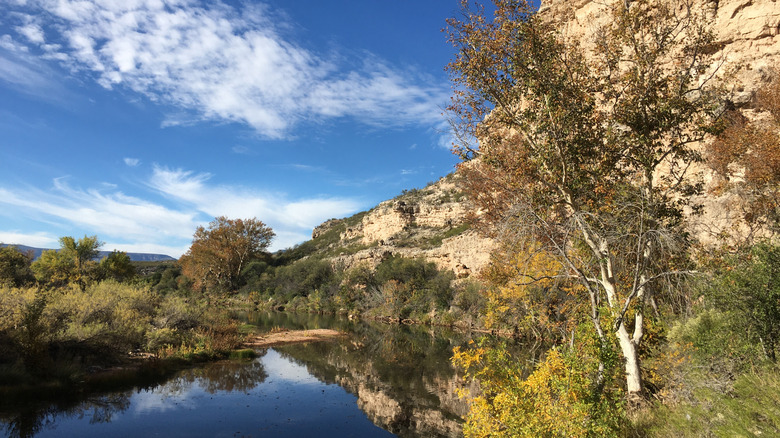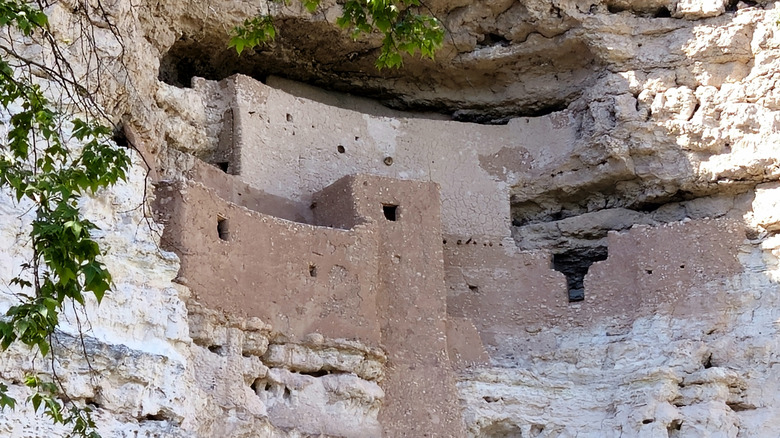Between Phoenix And Flagstaff Is Arizona's High Desert Hideaway With Cliffside Ruins And Small-Town Charm
While Arizona's outdoor meccas of Flagstaff and Sedona get a lot of attention, there's a small river valley town an hour closer to Phoenix that's rich in history, wild animal experiences, and outdoor access. Visitors searching for red rock formations, small town charm, and a forgiving semi-desert climate should head to Camp Verde. Considered the most central town in Arizona, it's just under 100 miles away from Phoenix Sky Harbor International Airport and only a 4.5-hour drive from Las Vegas, making it a worthy addition to a Las Vegas and Grand Canyon road trip.
Flagstaff offers cooler weather and is one of the snowiest towns in America because of its high elevation, while Sedona attracts hikers, bikers, and mindful spiritual seekers, but rural Camp Verde with a population of about 12,000 offers uncrowded access to trails, camping, rivers, and lakes in a surprisingly lush desert valley. It also has just enough amenities, such as restaurants and breweries, to serve visitors without ruining the rural charm. Camp Verde is surrounded by a mix of public lands including Prescott National Forest, multiple state parks, a national monument just outside town, and several hikeable wilderness area canyons.
Must-do outdoor activities near Camp Verde
The Montezuma Castle National Monument sits just outside town limits and ranks No. 1 for activities in Camp Verde on Tripadvisor, thanks to the impressive five-story Native American cliffside dwelling that's the focal point. The 900-year-old ruins aren't far from Interstate 17, and the 1,600-acre park is highly accessible by car. Once there, an easy 0.3-mile hiking loop takes you along the small Beaver Creek and past the ruins. Montezuma Well is a separate piece of the National Monument about 11 miles away, but even with this side trip, it's only about a half-day excursion.
To stretch your legs for longer, the Prescott National Forest to the west holds several trails for exploring canyons and desert grasslands on foot. The Copper Canyon Trailhead is less than 3 miles from downtown Camp Verde and provides access to a 4-mile loop with a mellow grade and forest views. Further south is the popular Fossil Creek Wilderness with an out-and-back hike to an impressive waterfall and swimming, but you'll need a permit during the busy season between April and October.
At the end of a long day outside, settle in for a pint at Verde Brewing Company, rated 4.5 stars on Tripadvisor. They offer a happy hour special and 12 craft beers brewed on-site, along with delicious pub food (try the nachos!). Grab an Italian dinner at the surprisingly polished Moscato, of which one Google Reviews user says they were, "astonished at the high tone and decoration of the place. It appeared out of place in this self-consciously rustic town."
Have a wild encounter with nature
One of the more surprising attractions in the Verde Valley is the Out of Africa Wildlife Park & Sanctuary, which offers African-style safari tours by shuttle bus or on foot through the 104-acre park 12 minutes northeast of Camp Verde. The passion project of a large cat-loving couple, Out of Africa gives visitors a chance to see non-native animals such as lion, tiger, giraffe, rhinoceros, hyena, lemurs, monkeys, and some North American species like black bear, grizzly bear, and gray wolf. At the time of this writing, tickets cost $43 for a basic adult admission with add-on options to view a predator feeding and ride a series of ziplines that zig and zag throughout the park and over several animal enclosures.
To the northeast, there is another chance to see and interact with rarely seen animals at the Sedona Wolf Sanctuary, which is 15 minutes outside Camp Verde, not in Sedona (despite the name). The sanctuary hosts spiritual nature retreats, and day visitors can make appointments to meet the wolves and learn more about these native North American predators. The $111 ticket gets you a guided tour with education about the animals, a chance to meet wolves in their enclosures, and supports the non-profit that manages the sanctuary.


